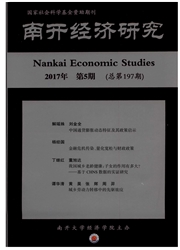

 中文摘要:
中文摘要:
采用1998—2007年我国非制造业工业企业相关数据,基于Gibrat定律的研究框架,本文分析了生产率、企业规模对我国非制造业工业企业成长及其规模分布的影响。结果表明:(1)企业规模与成长之间并不遵循Gibrat定律,企业规模对企业成长具有显著的负向影响;生产率对企业成长则具有显著的正向影响,且影响具有长期的持续性。(2)企业规模的扩张会带来平均企业规模的扩大与行业集中度的上升,使得企业规模(对数)分布更倾向于偏离正态分布;生产率的提高在推动平均企业规模扩大的同时会带来行业集中度的下降,使得企业规模更趋向正态分布。(3)此外,本文还分析了企业年龄、产权特征、地区差异以及出口需求等因素对此产生的影响。通过对不同行业的分类研究发现,不同行业的企业成长及其行为不仅具有相似性也具有差异性。本文的研究有助于更好地理解我国非制造业工业企业成长及其行为特征,也有助于更好地把握我国非制造业工业企业产业组织演进的动态过程及其背后的市场结构特征。这为推动我国工业企业成长、促进企业规模结构合理化以及产业结构优化等方面政策的制定提供了经验依据。
 英文摘要:
英文摘要:
Based on Gibrat’s law, the paper uses the related data of China’s nonmanufacturing enterprises from 1998 to 2007 to analyze the effects of the firm’s productivity and size on China’s non-manufacturing firm’s growth rate and size distribution. The results show that:(1)The effect of the firm size on the firm’s growth rate is negative which doesn’t comply with Gibrat’s law,while the effect of the firm’s productivity on the firm’s growth rate is significantly positive which is long and persistent;(2)The expansion of the firm size can enlarge the mean size of the firm and increase the concentration of the industry which tends to make the firm size(logarithmic)distribution deviate from the normal distribution,while the productivity improvement can enlarge the mean size of the firm and decrease the concentration of the industry which tends to make the firm size distribution be normal distribution;(3)In addition,this paper also analyzes the effects of firm’s age,enterprise property rights, regional differences and export demand on the growth of China’s nonmanufacturing enterprises. By classification of analysis on the different industries,we find that different types of China’s non-manufacturing firm growth and firm size distribution not only has similarity,but also has obvious differences. This study can help us better understand China’s non-manufacturing firm’s growth and its behavior,but also help us better grasp China’s non-manufacturing organization evolution and the market structure behind it.Thus,it provides empirical supports to set the policies to promote China’s non-manufacturing firm’s growth,and to rationalize and optimize the industrial structure.
 同期刊论文项目
同期刊论文项目
 同项目期刊论文
同项目期刊论文
 期刊信息
期刊信息
